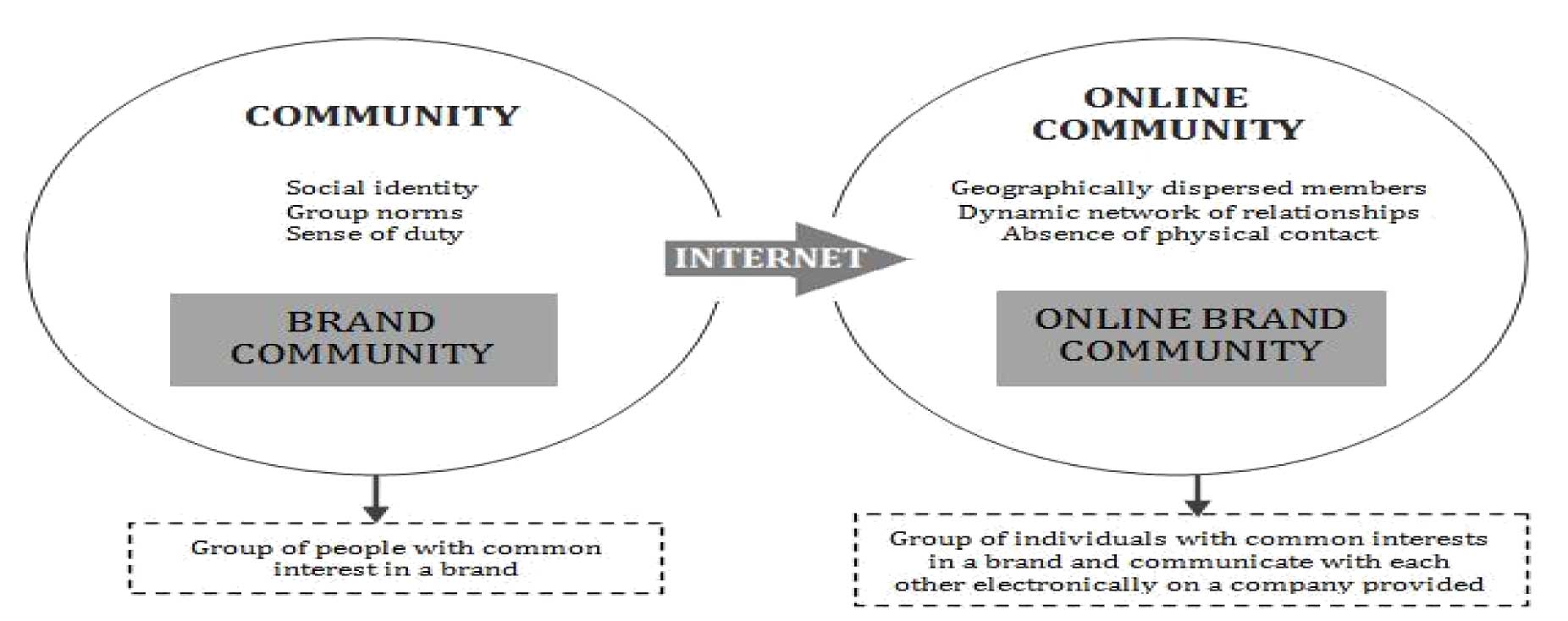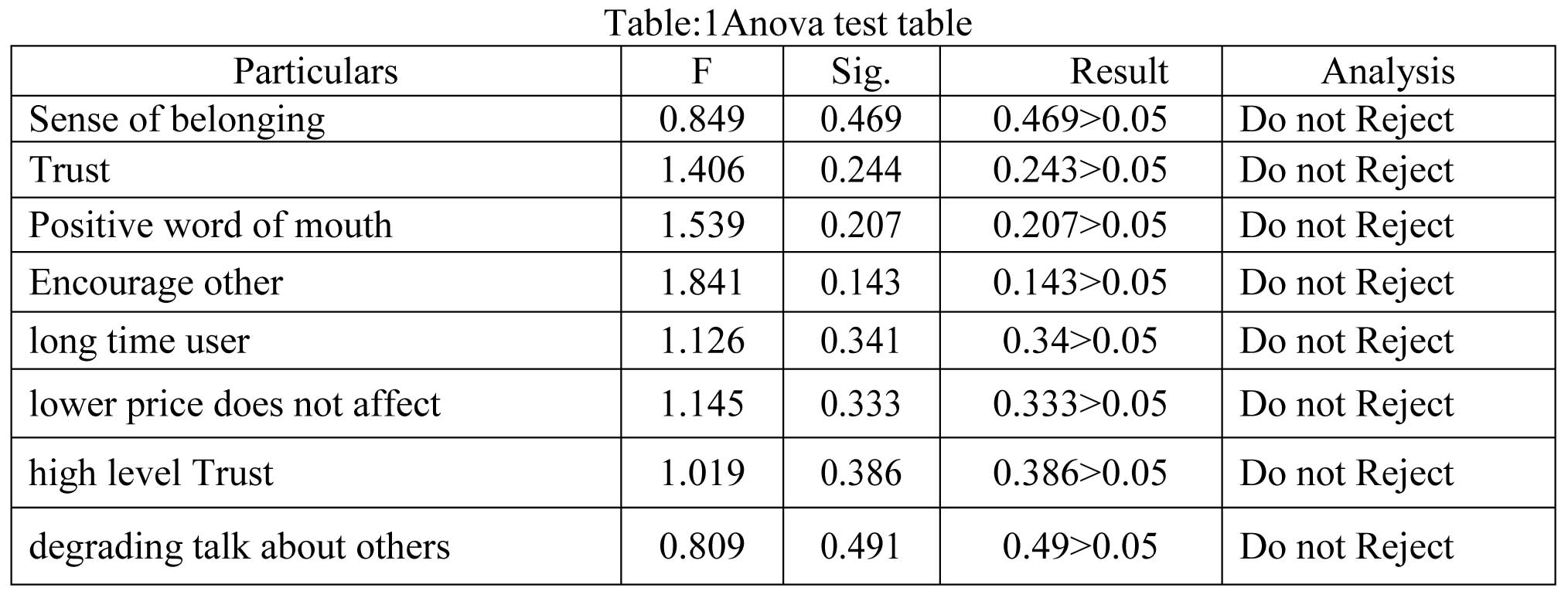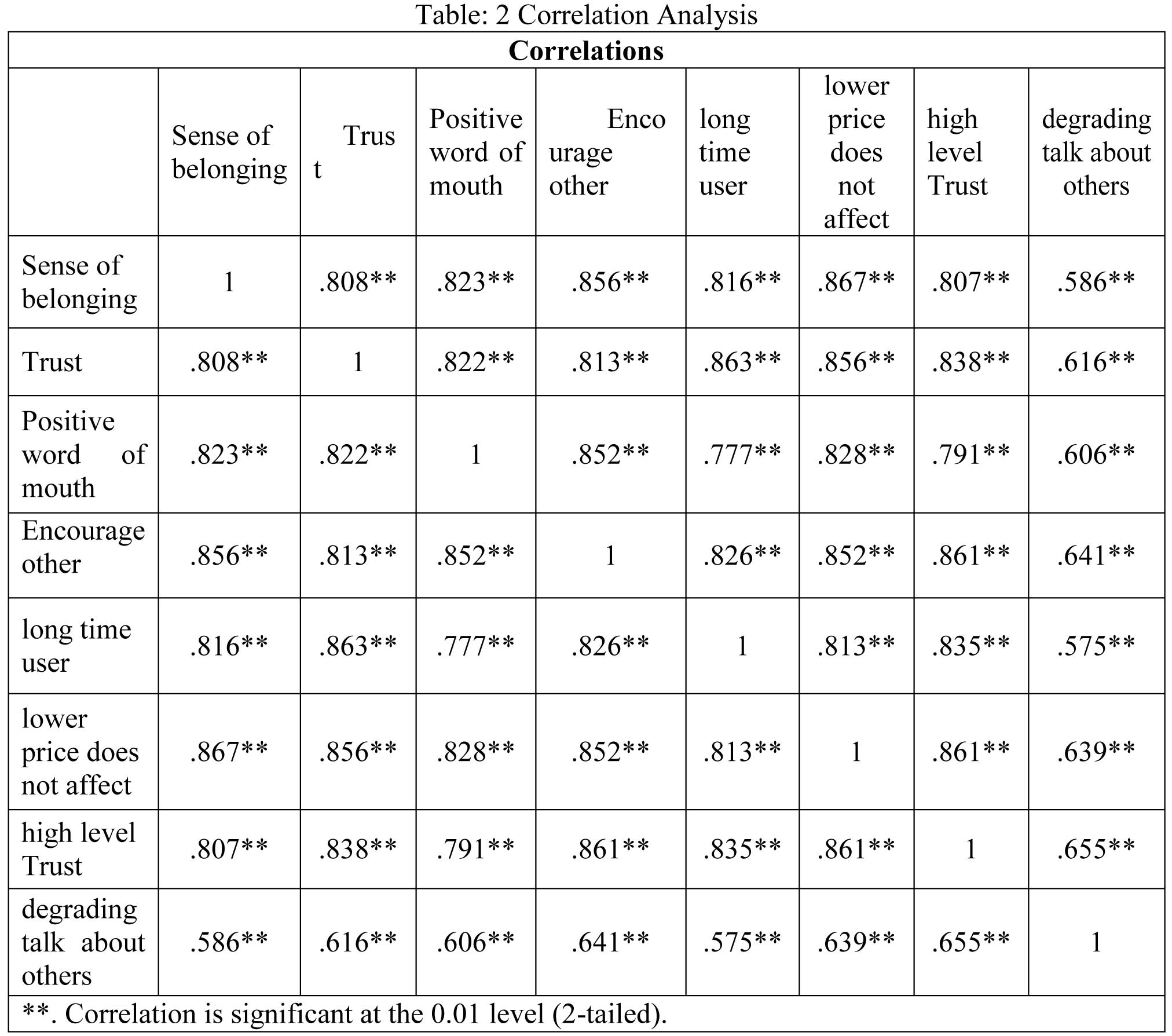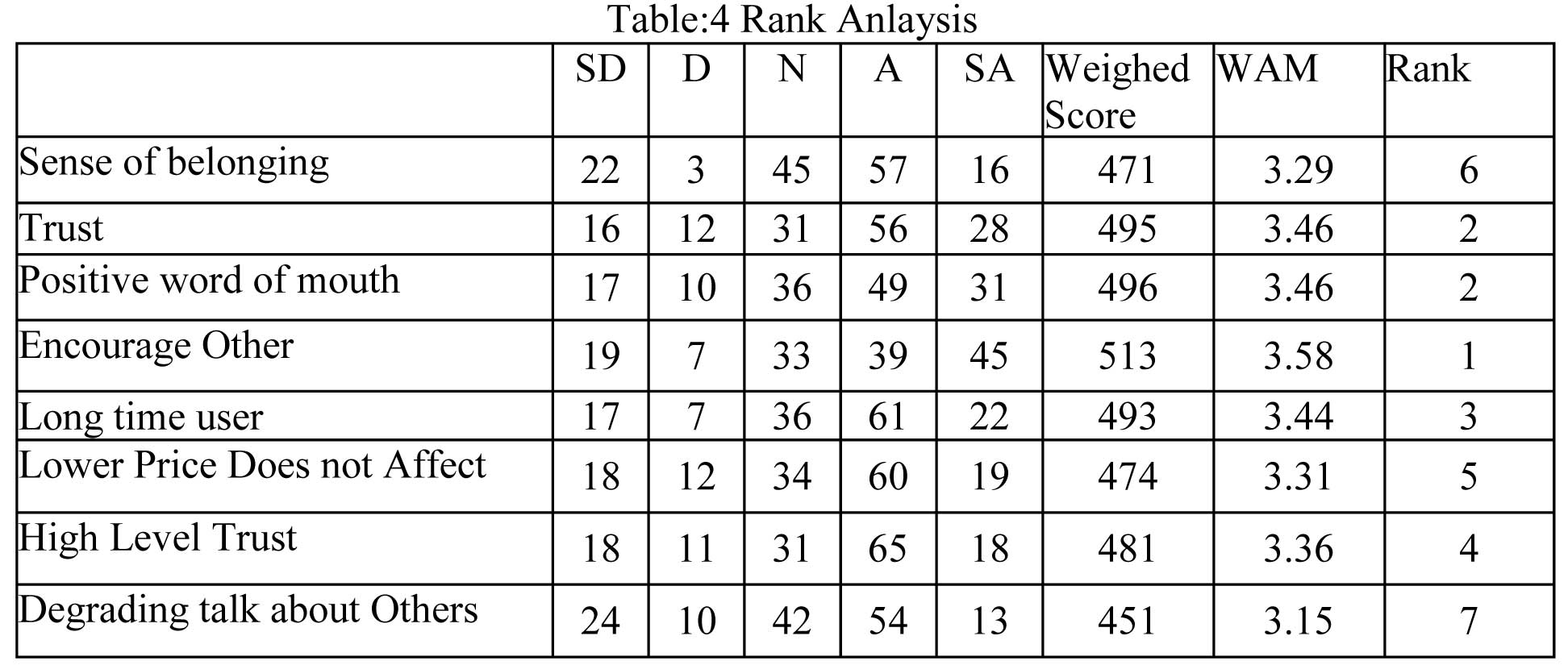Subscribe now to get notified about IU Jharkhand journal updates!
Online Brand Communities and Brand Loyalty: An Empirical Analysis
Abstract :
This paper attempts to investigate whether the use of online brand communities helps sporting goods brands in building brand loyalty or not. A survey has been used to collect primary data and questionnaire approach was used in the final analysis. The single cross-sectional descriptive research design was used to determine customers’ perception. SPSS and Microsoft Excel have been used to analyze and interpret the data. The data collected has been analyzed through a series of tools and procedures. Cross-tabulation, Graphical Representation, T-test, and Anova have been used. Replications among other samples are needed to validate the current finding. The study is confined to the customers located in Ahmadabad and Gandhinagar cities of Gujarat State So, the conclusion derived from the research cannot be made applicable as it is for the other parts of the states or other states. This paper makes a valuable contribution given the fact that there are only a limited number of comprehensive studies dealing with the Online Brand Communities and Brand Loyalty in Gujarat.
Keywords :
Online Brand Communities, Brand LoyaltyIntroduction :
The sportswear industry is highly competitive and is an interesting area to study based on a number of various reasons. The size of the industry, increasing trend towards more healthier lifestyles, old age people and females becoming more conscious about fitness, increasing trend on spending behaviour on sportswear and health clubs/ gym, These all factors in totality has changed competitive scenario of sportswear industry. In this cut-throat competition, branding remains the largest source of competitive advantage. The sports industry manufacturers have come to a phase where they offer the consumers with a basic need and an added value in terms of materially added value, which have become increasingly similar among the various products that are offered by the manufacturers. Products today are becoming increasingly similar. Moreover, it is generally recognized that the plenty of products are always available for purchase. Consequently, possessing a strong brand is crucial within the sports industry. The key to success is to create a differentiating, a unique, favourable, and strong brand image to provide customers with a reason to buy the brand and then work to maintain their loyalty and gain repeat purchase and recommend the same brands to their friends and family members. So, the current study is aimed to study the use of online brand communities helps sporting goods brands in building brand loyalty.
Theoretical Framework: Conceptual Roots
An online community is a dedicated, geographically scattered community based on an organized and dynamic network of relationships among participants sharing a common interest area. It is a cluster of people with common interests in a brand and who communicate with each other online in a brand platform provided by the company. Since the Internet overcomes geographical limitations the restrictions that have hindered the development of communities offline does not apply to the online communities.

Figure 1. From offline community to online community,Source: Adapted from Sicilia and Palazón (2008)
Literature Review
Vladimir Gritsenko2(2015) stated that online discussion threads dwelling on non- mainstream issues have all five features of face-to-face group work – size, interdependence, task, identity, and norms. The study concludes that though online forums introduce limitations to interactions, discussion threads can indeed be viewed as group communication.
Dr. Klaus Nicholas Schmidta, Ms. Kamakshi S. Iyera3(2014) analyzed that marketing strategies are no longer limited to any specific region; similar strategies may be duplicated across various cultures often only minor cultural adjustments may be needed.
Sonja Gensler et al 4(2013) stated that the rise of social media dramatically challenges the way firms to manage their brands. Key features of this social media environment with significant effects on branding are a shift from the firm to consumers as pivotal authors of brand stories in the branding process; a high level of interactivity manifested in social networks of consumers and brands; and a multitude of channels and brand stories that cannot be easily coordinated.
IremErenErdogmus&MesutCicek5(2012) suggested advantageous campaigns on social media are the most significant drivers of brand loyalty followed by the relevancy of the content, popularity of the content among friends and appearing on different social media platforms and providing applications. They also analyzed what type of contents are shared and preferred by social media users and the results imply that people share music, funny and extraordinary things online along with technological and instructive information.Melanie E. Zaglia6(2010) analyzed that individuals interact with many social network members characterized by different interests, purposes, and social identities. At the same time, they perceive shared the consciousness of kind and a distinct social identity with certain peers; sub-group members share their enthusiasm for the same brand and interact regarding their object of interest.
Wiegandt7(2009) analyzed that companies realise the potential of brand communities for enhancing their long-term relationship with customers and hence their brand loyalty. Therefore, the importance of brand communities has increased significantly over the last years.
Heding, Knudtzen&Bjerre8(2009) analysed that the personality and the relational approach both consider brand value as being created by the relationship between consumers and marketers, whereas the community approach focuses on the social interaction between community members and how it creates value. He even mentioned that a brand community needs interaction between at least two consumers in order to exist.
Algesheimer, Dholakia, & Herrmann 9(2005) found that nowadays brands try to get consumers to be more and more involved in their marketing practices and marketers are becoming more interested in learning and using brand communities. The reason for such great interest is the ability of brand communities to provide and spread information, interact with highly loyal customers and influence members‟ perceptions, intentions, and behavior.
Muniz AndO„Guinn10(2001) introduced three core community commonalities, which enable to distinguish the main features of the brand community: consciousness of kind, rituals and traditions, and moral responsibility. They have defined Consciousness of kind it as the intrinsic connection that members feel toward one another, and the collective sense of difference from others not in the community and rituals and traditions represent vital social processes by which the meaning of the community is reproduced and transmitted within and beyond the community. They have suggested that sense of moral responsibility plays a role in retaining old members of a community and helps others to fix problems where specialized knowledge is required or information needs to be shared.
Research Objective
To investigate whether the use of online brand communities helps sporting goods brands in building brand loyalty.
Research Methodology
The population base for current research is the population of Ahmedabad and Gandhinagar cities of Gujarat State. The sample was approached through electronic mail and direct contact method. The sample size is 143 respondents. The researcher collected 150 responses out of which 7 are an invalid response.The instrument used for data collection is Questionnaire consisting 18 questions. These questions include seventeen Multiple choice questions and one Likert scale questions which include seven statements which help to know consumers‟ perceptions towards the brand. The question was developed to get demographic data of consumers such as age, gender, and other questions include questions to study their perceptions and loyalty towards the brand community. It also includes questions related to their preferences about brand community. The researcher focused on only three online brand communities Nike+, PUMA Social, and Adidas. SPSS and Microsoft Excel have been used to analyze and interpret the data. Statistical techniques such as independent sample t-test, ANOVA, correlation, rank analysis and cross tabulation techniques have been used to test the various hypotheses.
Data analysis and interpretation :Inferential Statistics
Hypothesis1: There is no difference between consumer perceptions towards their community brand when classified by temporary
unavailability of product.

From the above table, it can be interpreted that all the variables of customer’s perception towards community brand do not reject null hypothesis
which means that there is no significance difference between consumer perceptions towards their community Brand when classified by temporary
unavailability ofproduct.
Hypothesis2: There is no correlation between various variables of consumer perception towards their community brand.

From the above table it can be concluded that there is a strong correlation among variables Hypothesis3: There is no significant difference
between consumer perception towards their community Brand and gender with respect to online brandcommunity.


From the above table, it can be interpreted that all variables except long time user and degrading talk about others brand reject null hypothesis
which means that there is a significant difference between consumer perception towards their community Brand and gender with respect to the
online brand community. While it can be interpreted that long time user and degrading talk about other brand do not reject null hypothesis which
means that there is no significant difference between consumer perception towards their community Brand and gender with respect to the online
brand community.
References :
Customer perception towards community brand influencing in building brand loyalty.

From the above table, it is observed that most significant important variables influencing in building brand loyalty are Encouraging other and followed by Trust and positive Word of mouth.
Major Findings for survey
Prior to entering the community the majority of members did not trust the community but became members anyway. Since becoming members of the online
brand community, 39 % agreed and 20 % strongly agreed with the statement I trust my community brand, indicating that a strong majority of members now
trust their community brand.The members of online brand communities seem to be committed buyers since 87 % of the respondents’ state that they have
recommended their community brand to their acquaintances. Since a majority of respondents, 40 %, are members of NIKE+ it would be natural that the
most bought brand would be NIKE. That is also the case as 50 % of the respondents usually buy the NIKEbrand.26 % are members of adidasmiCoach, yet
when examining what brand is usually bought among the respondents only 19 % state that they usually, buy the Adidas brand. It seems as if there is
a considerable amount of respondents who are members of the adidasmiCoach community but prefer to buy Nike products.
There is no significant difference between consumer perceptions towards their community Brand when classified by temporary unavailability of product.
All variables of consumer perception towards their community brand are highly correlated with each other.It is observed from the data that 1-4 pieces
are highly purchased and the number of male purchasing sporting good is considerably high in the age group of 21-30 years. Also, most of the female
purchasing sporting good also fall in the same 21-30‟ age group.It is observed from the data that Nike is highly usually purchased the brand and the
number of males purchasing Nike is considerably high in the age group of 21-30 years. Also, most of the female purchasing Nike also fall in the same
21-30‟ age group.
Limitations of research and future research directions
This research is limited to study only sporting goods brands. Since an attempt was made to examine if sporting goods brands´ online brand communities help in building brand loyalty so researcher studied only those brands which offer an online brand community for its consumers. The present study is based on a moderate sample size and area covered is Ahmedabad and Gandhinagar cities of Gujarat state only, therefore, the results of this study cannot be generalized. Future researchers are advised to investigate the subject from a financial point of view to see what financial benefits an online brand community can have for the company with larger and diversified samples to arrive at generalizations.
Conclusion
Responses on brand loyalty point that customers are willing to buy the same brand of sporting goods which they are using currently, but if these brands are not available in store they don’t mind switching to some other brand. Hence, manufacturers should make their brands available in the market as switching cost from one brand to another is not very high in such competitive scenario. Brand managers may enhance consumer satisfaction, commitment, and word‐of‐mouth advertising by developing online brand communities and promoting consumers' participation in them to increase brand loyalty. Online behavior is constantly changing and removing old paradigms, not only the brand managers but also the R&D managers must understand online behavior if they wish to develop online communities around their brands beneficial and sustainable for long period.
References :
- Aaker, D. A. (1991), “Managing brand equity capitalizing on the value of a brand name; managing brand equity capitalizing on the value of a brand name”. New York: FreePress.
- Abrahamsen, A., & Hartmann, B(2006), “Online brand community in action. A constitutive netnography: Advancing a wholesome ethnomethodological perspective on brand community”. Master's Thesis, School of Economics and Management, Lund University,Sweden.
- Algesheimer, R., &Dholakia, P. M(2006), “Do customer communities pay off?” Harvard business review, 84(11):pp.26-30.
- Algesheimer, R., Dholakia, U. M., & Herrmann, A(2005), “The social influence of brand community: Evidence from european car clubs”. Journal of Marketing, 69(3):pp. 19-34.
- Amine, A., &Sitz, L(2004),“How does a virtual brand community emerge? some implications for marketing research.” Research Paper, UniversityParis.
- Cova, B., & Pace, S( 2006), “Brand community of convenience products: Newforms of customer empowerment”- the case "my nutella the community". European Journal of Marketing, 40(9):pp.1087-1105.
- Dr. Klaus Nicholas Schmidta*, Ms. Kamakshi S. Iyera(2014), “Online Behaviour of Social Media Participants‟and Perception of Trust, Comparing SocialMedia Brand Community Groups and Associated Organized Marketing Strategies”, Procedia - Social and Behavioral Sciences 177,pp. 432 – 439
- Grotsche, I., &Vang Rasmussen, K(2010), “Value creation on facebook - A case study on how a facebook page can strengthen the relation between consumer and brand” Copenhagen BusinessSchool.
- Heding, T., Knudtzen, C. F., &Bjerre, M. (2009), “Brand management research, theory and practice”; brand management research, theory and practice. London:Routledge.
- HilleryJr, G. A(1955),“Definitions of community: Areas of agreement.” Rural Sociology, 20(2):111-123.
- IremErenErdogmus&Mesut Cicek (2012), “The impact of social media marketing on brand loyalty”, Procedia - Social and Behavioral Sciences 58 ( 2012 )pp. 1353 –1360
- Jang, H., Olfman, L., Ko, I., Koh, J., & Kim, K. (2008),“The influence of on-line brand community characteristics on community commitment and brand loyalty”. International Journal of Electronic Commerce, 12(3):pp.57-80.
- McAlexander, J. H., Schouten, J. W., & Koenig, H. F(2002), “Building brand community”. Journal of Marketing, 66(1):pp.38-54.
- Melanie E. Zaglia,2010, “Brand communities embedded in social networks”, Journal of Business Research 66(2013)
- Sonja Gensler&FranziskaVölckner&Yuping Liu-Thompkins& Caroline Wiertz,2013,” Managing Brands in the Social Media Environment”, S. Gensler et al. / Journal of Interactive Marketing 27 (2013)242–256
- Vladimir Gritsenko(2015),“Interaction on online forums and group communication: a case study of an IT support community”, Procedia - Social and Behavioral Sciences 236 ( 2016 ) pp.14 –24
- Wiegandt, P. 2009. “Value creation of firm-established brand communities”.GablerVerlag.
- Wood, L.(2000)“Brands and brand equity: Definition and management”. Management Decision, 38(9): pp.662-669
